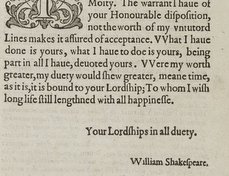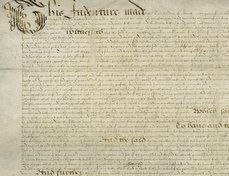Terms of use
Images that are under Folger copyright are licensed under a Creative Commons Attribution-ShareAlike 4.0 International License. This allows you to use our images without additional permission provided that you cite the Folger Shakespeare Library as the source and you license anything you create using the images under the same or equivalent license. For more information, including permissions beyond the scope of this license, see Permissions. The Folger waives permission fees for non-commercial publication by registered non-profits, including university presses, regardless of the license they use. For images copyrighted by an entity other than the Folger, please contact the copyright holder for permission information.
Copy-specific information
Title: The merry deuill of Edmonton : as it hath beene sundry times acted, by His Maiesties Seruants, at the Globe, on the banke-side.
Date: Printed by Henry Ballard for Arthur Iohnson, dwelling at the signe of the White-Horse in Paules Church yard, ouer against the great north doore of Paules, 1608.
Repository: Folger Shakespeare Library, Washington, DC, USA
Call number and opening: STC 7493, title page
View online bibliographic record
Peter Kirwan, "The Merry Devil of Edmonton, first edition," Shakespeare Documented, https://doi.org/10.37078/222.
Folger Shakespeare Library, STC 7493. See Shakespeare Documented, https://doi.org/10.37078/222.
Arthur Johnson published The Merry Devil of Edmonton in 1608, declaring the play to “hath beene sundry times Acted, / by his Maiesties Seruants, at the / Globe, on the banke-side.” In the 1630s, the play was bound in a volume of eight quartos in the library of King Charles I marked on the binding as “Shakespeare, Vol. 1.” Three of the quartos were published in 1631, including The Merry Devil of Edmonton (the fifth quarto) and the similarly anonymous Fair Em (second quarto), which may imply that the current availability of these texts was part of the reason for their inclusion (Kirwan 2011). The play was also listed as Shakespeare’s in a 1653 Stationers’ Register entry by Humphrey Moseley.
The play’s connection to the King’s Men, Shakespeare’s company, occasioned interest in the play during the nineteenth and early twentieth centuries, and several compilers of disputed plays included it in their volumes, including C.F. Tucker Brooke in his influential The Shakespeare Apocrypha (1908). Peter Kirwan argues that the play has close connections to The Merry Wives of Windsor and reflects the company’s continuation of a Falstaffian tradition (Kirwan 2015, 106-13), while Barbara Traister traces its development of the stage conjurer figure. Judging by the number of early modern editions (1608, 1612, 1617, 1626, 1631, 1655) the play enjoyed some measure of longevity and popularity.
The Shakespeare attribution currently enjoys no support, and the play was excluded from the 2013 edition of disputed plays William Shakespeare and Others: Collaborative Plays (Sharpe 2013, 726-7). The most enduring authorship argument is that for Thomas Dekker, made most fully in the only modern critical edition of the play by William Amos Abrams.
Written by Peter Kirwan
Sources
William Amos Abrams, ed., The Merry Devil of Edmonton (Durham: Duke University Press, 1942).
Peter Kirwan, "The First Collected “Shakespeare Apocrypha,” Shakespeare Quarterly 62.4 (2011): 594-601.
Peter Kirwan, Shakespeare and the Idea of Apocrypha (Cambridge: Cambridge University Press, 2015).
Will Sharpe, "Authorship and Attribution" in William Shakespeare and Others: Collaborative Plays, eds Jonathan Bate and Eric Rasmussen, with Jan Sewell and Will Sharpe (Basingstoke: Palgrave Macmillan, 2013): pp. 643-747.
Barbara Howard Traister, "Dealing with Dramatic Anonymity: The Case of The Merry Devil of Edmonton" in Anonymity on the Early Modern Stage: "What’s in a Name"? (Farnham: Ashgate, 2011): pp. 99-112.
Last updated January 25, 2020










